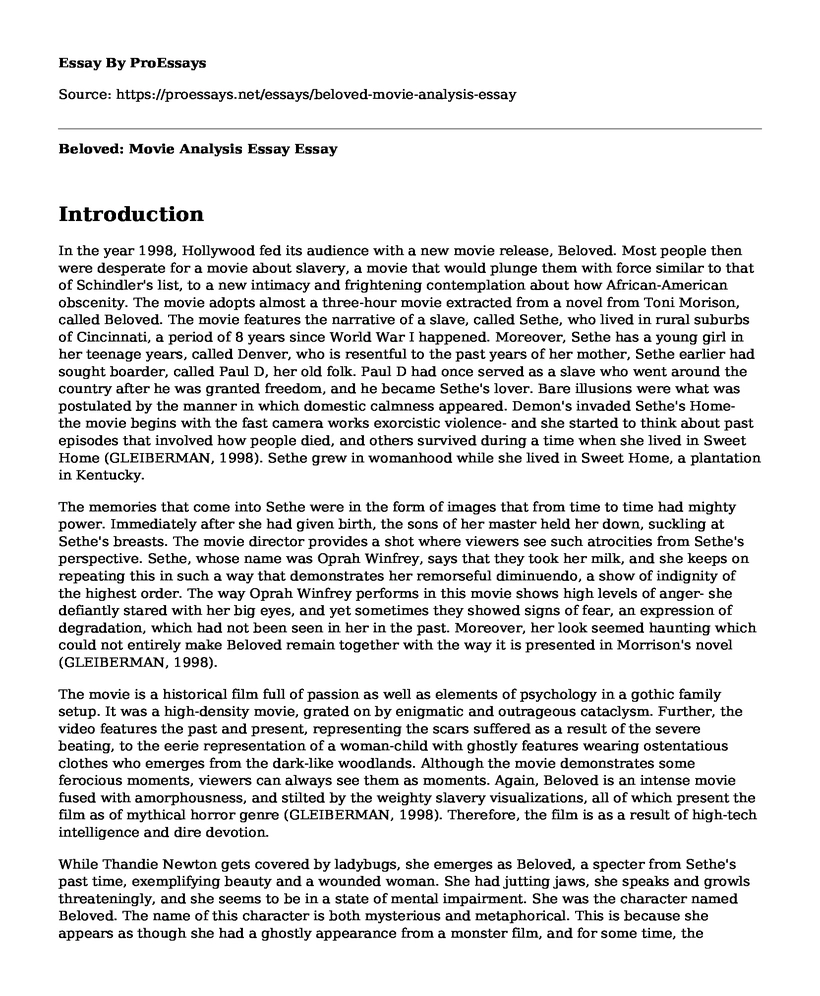Introduction
In the year 1998, Hollywood fed its audience with a new movie release, Beloved. Most people then were desperate for a movie about slavery, a movie that would plunge them with force similar to that of Schindler's list, to a new intimacy and frightening contemplation about how African-American obscenity. The movie adopts almost a three-hour movie extracted from a novel from Toni Morison, called Beloved. The movie features the narrative of a slave, called Sethe, who lived in rural suburbs of Cincinnati, a period of 8 years since World War I happened. Moreover, Sethe has a young girl in her teenage years, called Denver, who is resentful to the past years of her mother, Sethe earlier had sought boarder, called Paul D, her old folk. Paul D had once served as a slave who went around the country after he was granted freedom, and he became Sethe's lover. Bare illusions were what was postulated by the manner in which domestic calmness appeared. Demon's invaded Sethe's Home- the movie begins with the fast camera works exorcistic violence- and she started to think about past episodes that involved how people died, and others survived during a time when she lived in Sweet Home (GLEIBERMAN, 1998). Sethe grew in womanhood while she lived in Sweet Home, a plantation in Kentucky.
The memories that come into Sethe were in the form of images that from time to time had mighty power. Immediately after she had given birth, the sons of her master held her down, suckling at Sethe's breasts. The movie director provides a shot where viewers see such atrocities from Sethe's perspective. Sethe, whose name was Oprah Winfrey, says that they took her milk, and she keeps on repeating this in such a way that demonstrates her remorseful diminuendo, a show of indignity of the highest order. The way Oprah Winfrey performs in this movie shows high levels of anger- she defiantly stared with her big eyes, and yet sometimes they showed signs of fear, an expression of degradation, which had not been seen in her in the past. Moreover, her look seemed haunting which could not entirely make Beloved remain together with the way it is presented in Morrison's novel (GLEIBERMAN, 1998).
The movie is a historical film full of passion as well as elements of psychology in a gothic family setup. It was a high-density movie, grated on by enigmatic and outrageous cataclysm. Further, the video features the past and present, representing the scars suffered as a result of the severe beating, to the eerie representation of a woman-child with ghostly features wearing ostentatious clothes who emerges from the dark-like woodlands. Although the movie demonstrates some ferocious moments, viewers can always see them as moments. Again, Beloved is an intense movie fused with amorphousness, and stilted by the weighty slavery visualizations, all of which present the film as of mythical horror genre (GLEIBERMAN, 1998). Therefore, the film is as a result of high-tech intelligence and dire devotion.
While Thandie Newton gets covered by ladybugs, she emerges as Beloved, a specter from Sethe's past time, exemplifying beauty and a wounded woman. She had jutting jaws, she speaks and growls threateningly, and she seems to be in a state of mental impairment. She was the character named Beloved. The name of this character is both mysterious and metaphorical. This is because she appears as though she had a ghostly appearance from a monster film, and for some time, the audience is struck by her ghoulish surprises, as well as the audience urge for more revelation. In the end, viewers come across an episode that Beloved has been working towards: a flashback where her former master traced Sethe, who needs to bring her and her child back, this was after Sethe had run away from Sweet Home (GLEIBERMAN, 1998). The response Sethe gives was one that was explosive and instantly instinctive, one that was moral and full of unforgiveness.
Conclusion
The movie shows this unusual event as a way of unseen revenge that could ride almost every viewer through the sanity edge. In this incident, however, insanity and rage are covered up. To make Beloved applicable in life, the audience needs to grasp the idea of how a female parent could come that far- and in their minds, at least, that's what the audience does. However, there is no assurance that the movie applies in the audience cases at heart. Beloved, as a character disassociates the viewer from the horror that she postulated, and upon the revelation of her identity, the dramatic concentration diverges and gets lost somehow. The character goes away from struggle's that Sethe underwent and re-orients itself to dreary, centered on the importance of self. The director of the film directs Beloved in an intelligent and free-minded manner that the seriousness depicted by the tone used is a show of his quest for moral sanctity (GLEIBERMAN, 1998). The movie is lecture-like, not the nature that attracts awards, but one that wins awards.
References
GLEIBERMAN, O. (1998, October 23). Beloved. Retrieved from https://ew.com/article/1998/10/23/beloved-3/
Cite this page
Beloved: Movie Analysis Essay. (2022, Nov 16). Retrieved from https://proessays.net/essays/beloved-movie-analysis-essay
If you are the original author of this essay and no longer wish to have it published on the ProEssays website, please click below to request its removal:
- Theme Construction in Kurosawa's Dreams
- The Downfall Film Analysis Essay Example
- Research Paper on Political Talk Show (Laura Ingraham)
- Research Paper on Rising Chinese Fashion Brands: Impact on Global Markets
- Essay Sample on William Caxton: Preserving Medieval Literature and its Significant Cultures
- Essay Sample on Winslow Homer: Comparing Visual Messages in The Fog Warning and The Lookout
- The Impact of Social Media on Families: 72% of Smartphone Holders Connect Online







